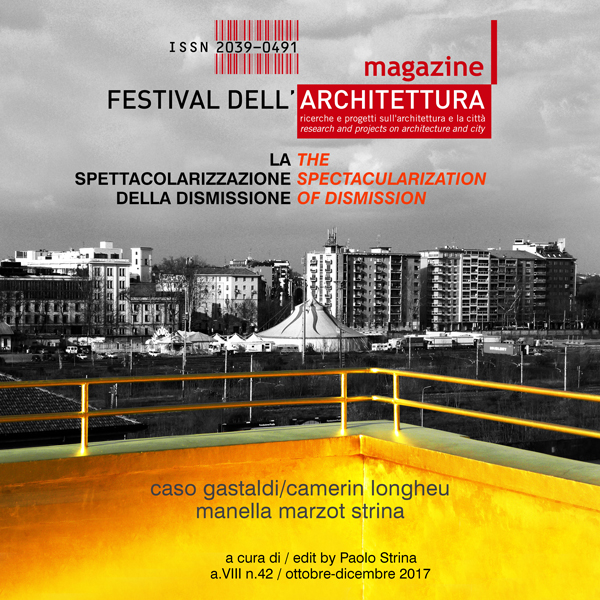Staging the industrial past. Current experiential strategies between Amsterdam, Rotterdam and Copenhagen
Published 2017-12-16
Keywords
- Former Disused Industrial Areas,
- Urban Regeneration,
- Netherlands
How to Cite
Abstract
The article investigates the current rampant trend consisting in the regeneration of former disused industrial areas according to a sought-after "mixité" character made of culture, temporality, ephemeral, flexibility. The preliminary mapping of phenomena under way in the transformation of the city in crisis, between Amsterdam, Rotterdam and Copenhagen, brings out the role of the local community in triggering a process of value in the institutional absence of planning that is no longer able to promote it and handle it. This leads to places of / in transition that host functions of a predominantly cultural nature, promoted by a new type of "2.0" actors such as start-ups, creative industries, young entrepreneurs and cultural operators.
The abandoned former industrial area aims to transform itself, therefore, into an urban centrality through gradual self-triggering actions, planned in compliance with medium-long-term time schedules. This policy, supported by adequate urban planning tools, contributes to the reactivation of the latent potential of the disused space resource, while awaiting structural projects that are aimed at permanent regenerating interventions.
References
- Abrahams, Tim, What culture is to a city. Architectural Review, January, 2016
- Bakker, Riet; Paul Achterberg, Frank de Josselin de Jong, Olof Koekebakker, Lodewijk Baljon, Joan Busquets. Kop van Zuid 2, Rotterdam, 1999
- Caso, Olindo; Cavallo, Roberto; Hybrid Buildings Celebrate the Collective Realm. Design Research at the TU Delft, In: E. Fidanoglu (ed.), Educating the Future: Architectural Education in International Perspective, (pp. 29-42). Proceedings of the EAAE Conference ‘Educating the Future’, Istanbul Kultuur University Publication 195. Istanbul: Golden Medya, 2013
- Cavallo, Roberto; Caso, Olindo; Design Research in an Environment of Change. The ‘Green Approach’ in Urban Regeneration; In: R. Cavallo, S. Komossa, N. Marzot, M. Berghauser Pont, J. Kuijper (eds.), New Urban Configurations, (pp. 969-975). Proceedings of the EAAE-ISUF Conference ‘New Urban Configurations’. Faculty of A&BE, TU Delft, October 2012. Amsterdam: IOS Press, 2014
- Dorsten, Tim van; Tweede leven voor Rotterdamse Fenixloodsen. Accessed 8-12-2017. https://www.duurzaamgebouwd.nl/projecten/20150130-tweede-leven-voor-rotterdamse-fenixloodsen; 2015
- Evans, Graeme; Creative cities, creative spaces and urban policy, Urban Studies 46: 1003-1040, 2009
- Miles, Steven; Paddison, Ronan; Introduction: the rise and rise of culture-led urban regeneration, Urban Studies 42: 833-839, 2005
- O’Sullivan, Feargus; How Copenhagen paused its waterfront redevelopment. Accessed 8-12-2017. https://www.citylab.com/solutions/2016/02/copenhagen-paper-island-waterfront-redevelopment-creative-business-copenhagenize/463137/, 2016
- Pine II, Joseph B., James H. Gilmore;The experience economy. Work is Theatre & Every Business a Stage. Boston: Harvard Business Press, 1999
- Plaza, Beatriz; On some challenges and conditions for the Guggenheim Museum Bilbao to be an effective economic re-activator; International Journal of Urban and Regional Research 32: 506-517, 2008.
- Vermeulen Windsant, Xander De Parooldriehoek. Accessed 8-12-2017. https://xvwarchitectuur.nl/blog-parooldriehoek/, 2014

